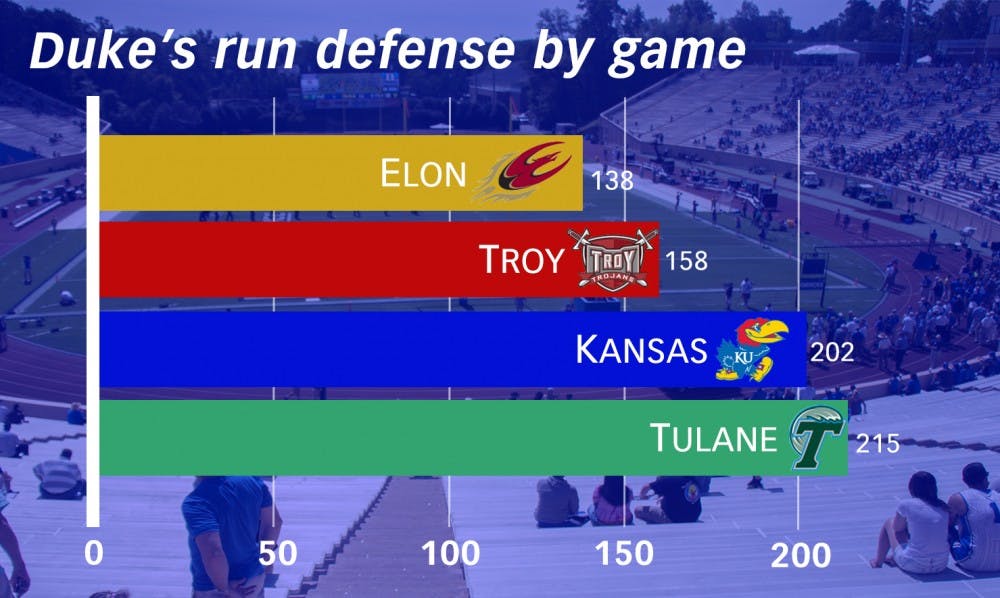Duke’s nonconference slate looked wonderful on the scoreboard: 174-46. But on paper, some of the numbers don’t look quite as nice.
Four games into the season, a statistical oddity has emerged. The Blue Devils are giving up the seventh-fewest points in the country at just 11.5 points per contest, but opponents are gashing them for 182.3 yards per game on the ground, a mark that ranks 90th in the country.
Duke has given up increasing yardage in every game this season, beginning with 138 yards against Elon. Troy followed suit with 158 rushing yards Sept. 7—100 of them coming in the first quarter—and Kansas carved out 202 against the Blue Devils in Durham. Last weekend, Tulane continued the troubling trend, getting to the second level and churning forward for 215 yards.
The disparity between Duke’s rankings in the two categories is one of the widest margins the country. Plotting points per game against rushing yards allowed per game for every team in the FBS, it’s clear that the Blue Devil defense is doing an incredible job of bending, but not breaking.

The regression predicting points per game allowed from rushing yards allowed returns a coefficient of 0.0997, meaning that every 10 additional rushing yards predicted a one-point increase in points allowed per game. According to that model, Duke should be allowing 28.2 points per contest. Granted, it’s an overly simplistic model that neglects several other pertinent variables that undoubtedly affect points allowed—for instance, the Blue Devils’ 32nd-ranked third down conversion defense of 31.8 percent or its 84th-ranked redzone defense (nine scores in 10 trips)—but it helps prove the point that a porous rushing defense should be giving up more than 11.5 points per game.
The one team with numbers similar to Duke’s is Temple, which ranks 94th in rush defense but ninth in points per game allowed. The Owls are 2-1 on the year, and their stingy defense can partly be attributed to their 14 takeaways this season, most in the nation. The Blue Devils have generated seven turnovers this season, five of which came last weekend.
Duke’s opponents this season haven’t exactly been the running-back-heavy Wisconsins and Oregons of the world—only Kansas cracks the top 50 nationally in yards per game. Troy ranks 111th in the country at 101.8 yards per game, and Elon—Duke’s opening-day opponent—has rushed for just 104.5 yards per game against its two FCS opponents after grinding out 138 against the Blue Devils in August.
In 2013, Duke’s defense made marked improvement in defending both the run and the pass, shaving off 51 total yards from 2012’s 469-yard average. But after holding opponents to 27.4 fewer rushing yards per game in 2013 and suffering the loss of All-ACC linebacker Kelby Brown before the season, the Blue Devils are in danger of regressing in that category in 2014.
As you might expect, the road won’t get any easier for Duke, because the ACC has some of the most potent rushing attacks in the nation. Three of the Blue Devils’ opponents are in the top 20 in the nation in rushing yards per game—Pittsburgh ranks 10th with 304, followed by Georgia Tech at 14th with 292 and Syracuse checks in at 19th with 265.
Last season’s Blue Devils completed a perfect nonconference slate in which they allowed just 13 points per game—with Duke’s offense, good enough to chalk up a victory on most Saturdays. But the scoreboard was not as friendly to the defensive unit in ACC play, giving up 29.9 points per contest. That’s a result that will have to be reversed for a Blue Devil repeat bid at the Coastal Division crown.
For all of those reasons, Saturday night’s primetime showdown with Miami will be a barometer test for Duke in many facets of the game, but there may be no more pressing question than how the Blue Devil run defense will hold up against a physical ACC squad and the conference’s most dynamic tailback.
Duke Johnson is healthy and back in the lineup for the Hurricanes after missing last November’s meeting in Durham due to injury. The junior was sorely missed by Miami, which still racked up 184 yards on the ground—and 6.4 yards per carry—but lacked his open-field explosiveness and didn’t find the endzone with the running game, falling 48-30 to the Blue Devils.
As a freshman playing in the 2012 edition of Blue Devils-Hurricanes, Johnson put up an eye-popping 181 yards by himself—on 11.0 yards per touch—and found paydirt three times. Miami rode his coattails to a 52-45 road win, totaling 263 rushing yards.
To say that Johnson will be on the minds of every Blue Devil defender come 7:30 p.m. Saturday night could qualify for understatement of the year. The run defense will have to buckle down to try to keep the Hurricanes under the 30-point threshold for the first time since 2010.
Get The Chronicle straight to your inbox
Signup for our weekly newsletter. Cancel at any time.

